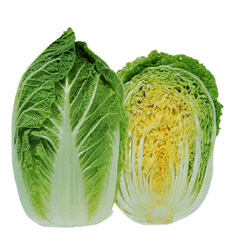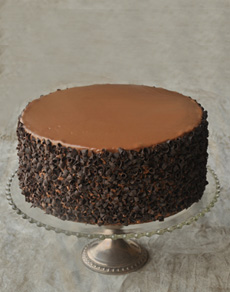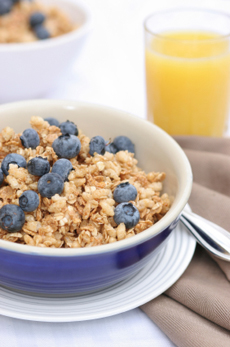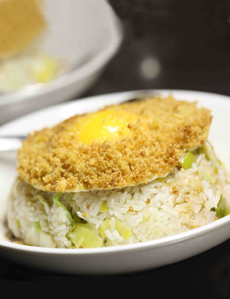|
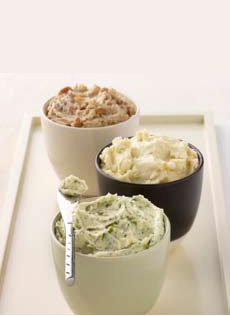
Compound butter is delicious atop a steak;
just don’t tell your cardiologist. Above, herb,
gorgonzola and hazelnut butters. Photo
courtesy AllenBrothers.com.
|
|
Here’s a treat from Chef Johnny Gnall: hazelnut butter—the compound butter, not the peanut butter spread alternative. He learned it a while back while working at Aziza restaurant in San Francisco, and is “still finding new uses for it every day.”
“For some reason, the hazelnut seems to sit in a class of its own, a bit more indulgent than pecans, walnuts, almonds and other nuts,” says Chef Johnny.
“Hazelnuts work beautifully in sweet recipes and savory ones alike. Their richness and unique flavor can exist in the background of a dish, or they can be the star, paired with nothing more than a bit of chocolate.
“They also hold some hidden potential: hazelnut butter! Almost any nut can be made into a compound butter, but hazelnuts have an unmistakable richness and a hint of sweetness that is just perfect for everyday or special occasions.”
|
COMPOUND BUTTER RECIPE
Ingredients
1 quart raw hazelnuts (peeled nuts are best, but unpeeled will work as well)
1 quart whole milk (or more as needed)
Salt
Maple syrup
Preparation
1. Combine. Add hazelnuts and milk to a sauce pan. Milk should completely cover the hazelnuts, plus a little more to accommodate evaporation. You can always add more milk if the level drops.
2. Boil. Bring to a boil, then reduce to a simmer. Cook for at least thirty minutes, and up to an hour. When you take the pan off the heat, the hazelnuts should be soft to the touch, but not so soft that they break down completely. Strain the milk out and reserve it.
3. Purée. Add hazelnuts to a blender with half a cup of the milk and purée until smooth. If needed, add milk, a bit at a time, to facilitate the puréeing. But do so cautiously, as too much milk will leave you with hazelnut soup instead of hazelnut butter.
4. Season. Once you have a smooth, thick, puréee, use a spatula to get it into a large bowl. Season with a pinch of salt and some maple syrup. The goal of the syrup is to add just enough sweetness that it brings out the natural sweetness of the hazelnuts. Add it a tablespoon at a time, incorporating well with a whisk and tasting afterwards. The whole batch shouldn’t take more than a few tablespoons of maple syrup.
5. Strain. Finally, you have the option to strain the hazelnut butter through a chinoise. This step is only necessary if you are are going for that impeccable, restaurant-quality texture. Otherwise, the hazelnut butter is quite smooth and delicious even without straining. Also note that if you used unpeeled hazelnuts, you may prefer to strain out the skins.
6. Cool. At this point, the butter is in a soft state. Let it stand for an hour in a cool place, covered, so the flavors can develop; then refrigerate to harden.
HOW TO STORE HAZELNUT BUTTTER
There are three basic different ways to store the butter:
In an airtight container—plastic, glass or a ceramic crock with a gasket seal (if air gets in, butter can easily pick up other aromas in the fridge).
In a roll: As the butter hardens, place it on a piece of wax paper (or plastic wrap) and roll it into a sausage shape, about 1-1/2 inches in diameter. Twist the ends of the wax paper and place into a plastic storage bag. Slice it by the piece as you need it. A circular slice looks great atop a steak.
For entertaining, press the butter into molds to create stars or other shapes; create balls with butter paddles; or simply press it into ramekins.
You also can freeze the butter for a month or more.
HOW TO USE HAZELNUT BUTTTER
As a bread spread: on everything from toast to croissants.
In cookies: Add hazelnut flavor to any recipe.
On vegetables, rice, pasta, pancakes and everywhere you use butter.
On steaks and chops: If you top your meats with a pat of regular butter, hazelnut butter will add even more flavor.
Hazelnut butter makes a great homemade gift for any occasion, from Valentine’s Day to Thanksgiving and Christmas. Just fill mason jars and tie ribbons around them. Your friends and family will go nuts for it!
Pork Roast WIth Hazelnut Butter. For a special entrée, slather a pork shoulder or loin with hazelnut butter and roast it as you normally would. The sweetness of the butter, imparted from the maple syrup, pairs excellently with the pork. Its earthiness adds a whole new level of flavor. For a nice touch, finish the roast on broil for a few minutes to get a nice dark crust over the top. Friends and family will ooh and ah when the roast arrives at the table…but their mouths will be far too full to say anything after that!
More compound butter recipes.
|
